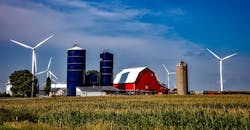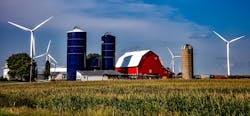Download this article as a .PDF
Wind power is one of the leading clean alternatives to fossil fuels for energy generation. It currently contributes about 6% to the United States’ power grid—a number that is expected to grow to 20% by 2020, according to the Department of Energy’s Wind Vision report.
To put that amount of power into perspective, there are currently more than 1,000 wind power projects currently operating in the U.S. utilizing 53,000 turbines (in 41 states) generating 84,143 MW. Continuing on the numbers trend, there are roughly 500 manufacturing facilities building those turbines and infrastructure, employing tens of thousands of workers to scale wind energy to solar sizes. While these wind farms are spread all over the U.S., a majority are spread across three states in particular: Texas (11,898), Iowa (3,965), and California (8,385), all of which provide power to millions of households in those respective states.
With all those turbines scattered over millions of acres, it begs the question of what impact these wind farms and turbines have on the environment and wildlife. Certainly, wind power provides a cleaner, greener footprint over fossil fuel-based plants with regard to carbon pollution, but are the claims of bird/bat deaths and migration interference a major issue? What about agriculture limitations and noise pollution? Are these cause for concern?
There are two sides to every story, and that’s certainly true when it comes to avian and bat fatalities from wind turbine impacts. According to an analysis published in 2015 by the Institute for Energy Research, around 2.5 million birds and bats were killed over a five-year period between 2010 and 2015 as a direct result of collisions with wind turbines. That’s certainly a high-enough number to cause concern, but when compared to building collisions (anywhere from 365 million to 988 million birds annually) and outdoor cat hunting (roughly 2.4 billion birds), those numbers seem to diminish the mortality impact caused by the turbines.
Surprisingly, the American Wind Energy Association (AWEA)—a D.C.-based trade association comprised of developers, manufacturers, and service providers—does not dispute that wind facilities have caused bird/bat fatalities. However, their numbers starkly contrast with those reported by the IER, reporting an estimated loss of only 134,000 to 230,000 annually (taken from an American Wind and Wildlife study). With that in mind, the AWEA states that it is actively pursuing research that will help lessen the mortality rate of bird/bat strikes and is even funding science and research to combat diseases associated with both species.
The environmental impact of wind energy is not without its controversies as well, with allegations of limiting or interfering with farmland, dispersing sound pollution, lowering property values, and even interfering with radar near military installations. On the farming front, a 2013 article on Master Resource (A Free Market Energy Blog) cites stories and statistics that detail the impingements to the farming community—including reduced crop yields, soil compaction, and rampant excavation. In other testimony, farmers see the inclusion of wind turbines as a boon to their crops, with the added airflow helping to expand their yields.
Noise pollution is also a concern for those who live within a mile of turbines and wind farms according to some reports, including one from the National Review that cites health concerns (specifically to low and sub-frequency sounds) along with the audible irritant. While those frequencies are known to have an effect on some individuals, the decibels average turbines produce is roughly 45 dB in an area of 980 ft., or roughly as loud as the typical refrigerator at that distance. At one mile, the dB’s are non-existent.
Like any technology, wind power has its benefits and drawbacks, and there are plenty of statistics and research endeavors to back both sides of the argument. There are some certainties, though, when it comes to wind power: Yes, it does have an impact on wildlife to some extent; yes, the environment is altered to some degree; and yes, it does produce noise pollution on a small scale and effects those susceptible to low frequencies. Maybe that’s the price we have to pay for producing a cleaner energy than coal or natural gas can provide, at least until the technology is refined.
About the Author
Cabe Atwell
Engineer, Machinist, Maker, Writer. A graduate Electrical Engineer actively plying his expertise in the industry and at his company, Gunhead. When not designing/building, he creates a steady torrent of projects and content in the media world. Many of his projects and articles are online at element14 & SolidSmack, industry-focused work at EETimes & EDN, and offbeat articles at Make Magazine. Currently, you can find him hosting webinars and contributing to Penton’s Electronic Design and Machine Design.




